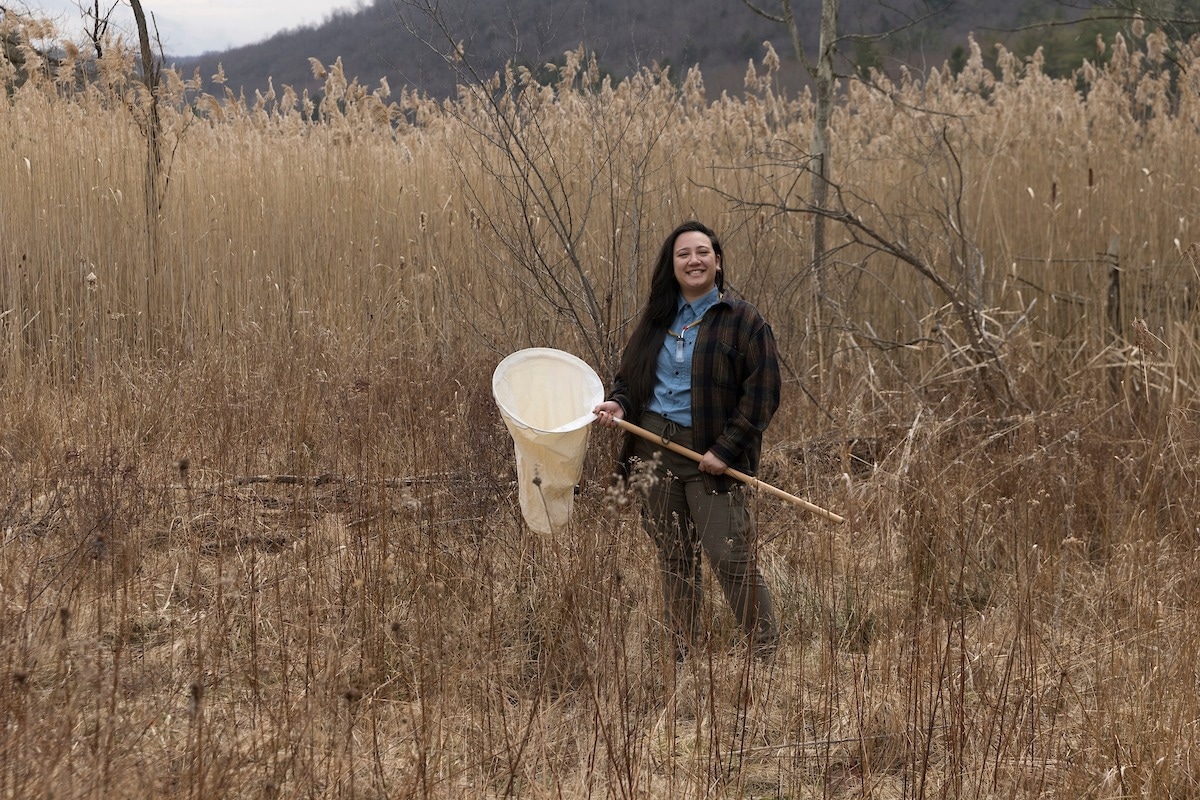In early spring, a walk through an old-growth forest will dazzle people with wildflowers, their jewel-like tones shining from the forest floor.
 Carmela Buono, a PhD candidate in biological sciences, photographed at the Nature Preserve, Thursday, March 31, 2022. Image Credit: Jonathan Cohen.
Carmela Buono, a PhD candidate in biological sciences, photographed at the Nature Preserve, Thursday, March 31, 2022. Image Credit: Jonathan Cohen.
Spring ephemerals like wild ginger, trillium, violets, and bloodroot, on the other hand, are in short supply in newer forests. The answer might be linked to Aphaenogaster sp., also known as the woodland ant.
Not a lot of people have heard of them, but they are the powerhouse of moving seeds and called ‘keystone dispersers.
Carmela Buono, Doctoral Candidate, Biological Sciences, Binghamton University
Buono is the lead author of the research published in Ecology and co-authored with Binghamton University Assistant Professor of Biological Sciences Kirsten Prior and undergraduates Jesse Lofaso, Will Smisko, Carly Gerth, and John Santare. The researchers studied understory plants and ant seed dispersal in 20 New York state forests that were half-old growth and half-regenerated.
Over 95% of New York state forests, including the Binghamton University Nature Preserve, are secondary forests that grew on land that had previously been cleared for agriculture. While parts of these regenerated forests, like that of the overstory, have rebounded well, they are lacking other elements of biodiversity—especially when it comes to understory plants like native wildflowers.
To disperse their seeds, several plant species depend on a mutual relationship with ants. According to Buono, northeastern North America is one of the key hotspots for ant – plant mutualism, though it also occurs in parts of Europe, South Africa, Australia, and northeastern Asia.
These plants evolved with seeds that have an appendage rich in fats attached to them, and that’s very attractive to woodland ants. Ants need fats just as much as protein and sugar, and it’s hard to find foods rich in fats in the forest.
Carmela Buono, Doctoral Candidate, Biological Sciences, Binghamton University
Woodland ants are a native species that thrive in logs, forest leaf litter, and beneath rocks. They are shiny black and medium in size. Woodland ants bring the seeds with fatty rewards back to their nests, where they are protected from rodents and other organisms. Once the fatty appendages have been consumed, the ants remove the seeds from the nest, displacing them far from the original plant. This arrangement is mutually beneficial.
There are so many interesting, intricate parts of this interaction depending on the types of seeds ants prefer, so you can get this beautiful mixing of flower species in forests.
Carmela Buono, Doctoral Candidate, Biological Sciences, Binghamton University
How Are Old-Growth Forests Different?
Buono emphasized that old-growth forests are rare treasures that play a key role in conserving species diversity. In some areas, pockets of the Northeast’s ancient forest cover remain, often on land deemed unfit for farming.
They vary from secondary forests simply from the ground up. Formerly cleared agricultural land is flat, whereas old-growth forests have a “pit and mound” topography.
Buono elaborates, “It’s uneven, from years and years of trees falling over.”
Pits are formed by the roots of toppled trees being lifted out of the ground, whereas mounds are formed by the extracted root and soil. Species in the two types of forests differ as well, with rapid colonizers moving into younger woodlands. In the understory of an established forest, there are usually more shade-tolerant plants.
Secondary forests have slightly fewer woodland ants, possibly due to their dislocation during years of agricultural use. Differences in forest canopies and the quantity of light hitting the forest floor could also play a significant role, but that has yet to be researched, Buono reports.
The real problem does seem to be competition from invasive slugs, which are found primarily in regenerated woodlands and have a taste for fatty seed appendages. Slugs frequently prefer forest edges, and secondary forests may be positioned closer to slug habitats, such as open meadows or active farms, according to Buono.
According to the researchers, to restore newer forests to a healthier state, we must look beyond the trees to the diversity of insects, which play an important role in the forest ecosystem.
“Ants are beneficial. They’re not as charismatic as butterflies or bees that help pollinate flowers, but they are just as important,” Buono concludes.
Journal Reference:
Buono, C. M., et al. (2023) Historical forest disturbance results in variation in functional resilience of seed dispersal mutualisms. Ecology. doi.org/10.1002/ecy.3978.